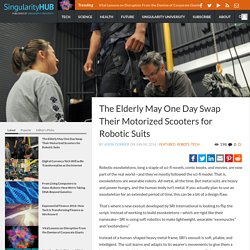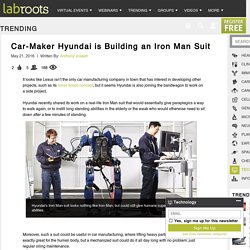

Movement-enhancing exoskeletons may impair decision making. Wearable Exoskeletons Will Have Built-In A.I. to Meld Human and Machine. This Augmented Reality Helmet Helps Firefighters See Through Smoke to Save Lives. The Elderly May One Day Swap Their Motorized Scooters for Robotic Suits. Réduit douleurs et fatigue. The Elderly May One Day Swap Their Motorized Scooters for Robotic Suits.
Robotic exoskeletons, long a staple of sci-fi novels, comic books, and movies, are now part of the real world—and they’ve mostly followed the sci-fi model.

That is, exoskeletons are wearable robots. All metal, all the time. But metal suits are heavy and power hungry, and the human body isn’t metal. Car-Maker Hyundai is Building an Iron Man SuitTrending. It looks like Lexus isn’t the only car manufacturing company in town that has interest in developing other projects, such as its hover board concept, but it seems Hyundai is also joining the bandwagon to work on a side project.Hyundai recently shared its work on a real-life Iron Man suit that would essentially give paraplegics a way to walk again, or to instill long standing abilities in the elderly or the weak who would otherwise need to sit down after a few minutes of standing.

Voici comment on se battait (vraiment) au Moyen-âge - 9 octobre 2014. This Exoskeleton Allows Paralyzed People To Walk. The world watched in awe last year when a paraplegic man strode onto the pitch at the football World Cup and took the first kick.

With the assistance of an incredibly hefty, Iron Man-style bodysuit, the man was able to control his movements with his thoughts and even experience the sensation of the strike. Avec ces chaussures de course, il est possible de courir à 40 km/h. N’est pas Usain Bolt ou Forrest Gump qui veut !

Mais désormais, il est possible de s’en approcher grâce à cette paire de chaussures de course inspirée des kangourous, et qui permet d’atteindre aisément les 40 km/h en courant. Keahi Seymour est un concepteur américain à l’origine de « The Bionic Boots », cette paire de chaussures de course qui permettent d’augmenter sa vitesse sans pour autant devoir réaliser plus d’efforts. Cette idée lui est venue lorsqu’il n’avait que 12 ans, devant un documentaire sur les kangourous. « Le présentateur a dit que si le kangourou se déplace avec une telle efficacité, c’est parce qu’il utilise ses tendons d’Achille comme des ressorts. Je me suis dit : Pourquoi ne pas reproduire cela dans un dispositif qui pourrait propulser un être humain ? » déclare-t-il. Yves Rossy: Fly with the Jetman. Jetpack Will Help Runners Hit 4-Minute Miles.
There are times when seconds count, and the ability to move quickly could mean the difference between life and death.

In combat, soldiers can carry upwards of 90 pounds in their rucksacks and on their bodies, which significantly reduces how fast they can move on foot. Jason Kerestes, a student at Arizona State University, has developed the 4 Minute Mile: a jetpack that helps soldiers move faster, without requiring them to physically exert more. While jetpacks are usually associated with flying around, this one just gives the runner a boost, helping them to shave off time while also decreasing the amount of effort put into the activity. Initial testing has shown that even while loaded up with the jetpack equipment, the runner was able to complete a 200-meter run faster and with decreased metabolic cost than when he ran on his own. Skully : le casque de moto connecté ultime. Android est partout : dans les téléphones, dans les tablettes, dans les télévisions et bientôt dans les voitures.

Mais pas encore dans les casques de moto. US Army Robots Will Outnumber Human Soldiers in a Decade. Exosquelette. Paraplegic In "Ironman Suit" Will Take The First Kick In The 2014 World Cup. The opening ceremony for the upcoming 2014 World Cup promises to be one to remember as, according to AFP News, a paraplegic individual will walk onto the pitch and give the first kick, all thanks to an Iron Man style bodysuit controlled by his brain.

The event, which takes place on Thursday 11 in Sao Paulo, Brazil, will unveil for the first time the exoskeleton which is the result of years of work by a dedicated team of 156 scientists from across the globe. Leading the research is Brazilian neuroscientist Miguel Nicolelis who first dreamt up the idea for the exoskeleton back in 2002. His ultimate goal is to allow paralyzed individuals to walk again, but he also wants to showcase his invention to the world to prove that Brazil is investing in things beyond football.
Les dessous technologiques des exosquelettes. Capteur de force, algorithme d'activation de mouvement, puce implantée dans le cerveau...

L'informatique embarquée et les technologies de pointe arrivent dans les exosquelettes. Les ossatures artificielles ou exosquelettes n'appartiennent plus au domaine de la science-fiction. Ils sont même présents depuis une dizaine d'années dans deux secteurs en particulier. Celui du médical tout d'abord, au travers des exosquelettes de rééducation (pour des patients capables de récupérer des capacités neuromotrices) et d'assistance (pour des patients paralysés). Mais également dans le secteur militaire. Une bonne partie des exosquelettes que l'on trouve actuellement sur le marché, c'est-à-dire ayant dépassé le stade de la recherche en laboratoire, sont en effet destinés à l'augmentation.
Robotic Suit Makes Chunks of Metal Light as Feathers for Korean Shipyard Workers. It started long ago, the merger of man and machine.

Power looms for hands, cars and trains for legs, and recently, computers for memory. Now, as robotic suits approach practicality, we’re climbing inside our machines and gaining awesome powers. Gilwhoan Chu, an engineer at Daewoo Shipbuilding and Marine Engineering, is testing a robotic suit (or exoskeleton) for workers in the firm’s shipyards. The suit’s hydraulic and electric actuators make 30 kg lumps of metal feel light as a feather. Workers standing anywhere between 160 cm and 185 cm tall can step into one of the exoskeletons by fastening their feet, thighs, waist, and chest to it with a series of straps. Maybe the most impressive feature of the Daewoo suit is its reported battery life—three hours of untethered use delivered from a backpack power source. US Navy Tests Exoskeleton to Boost Worker Strength and Productivity. Exoskeletons have made news in recent years for creating super-soldiers and allowing wheelchair users to walk again.
